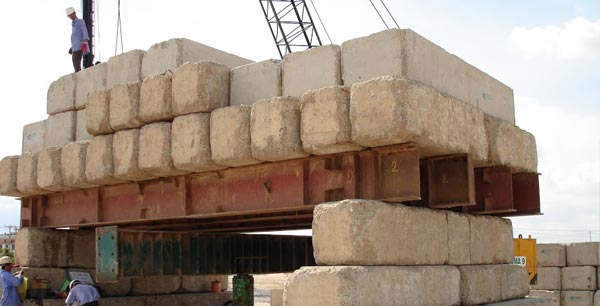Static Pile Compression Test is a mandatory procedure to confirm the design, construction and acceptance of pile foundations. The design engineer must specify the number, location and load of the test piles, according to the predicted bearing capacity of the piles. After having the test results, he needs to evaluate whether the results are consistent with his predictions, before deciding to construct the piles on a large scale. Below is a practical presentation of this basic design issue.
===============================

Read the test results
The test procedure for static load testing of vertical axial compression piles complies with the requirements of TCVN 9393:2012 “Piles – Field testing method using axial static compression load”. Note for contractors and supervision consultants during the test, according to clauses 4.4.2 and 4.4.6: The test load may only be increased to the next level when the pile settlement reaches Conventional stability. In short, the pile can be considered to have stopped settling at the current load level:
– Not more than 0.25mm/h for piles against large soil, sand, clay from plastic to hard
– Not more than 0.10mm/h for piles with friction in soft plastic soil – plastic flow
❓What is a load level
The static compression test will be performed with gradually increasing and then decreasing the load at each level, not pumping suddenly. The value of each load level is calculated as a % of the calculated load capacity of the pile according to the design. The time to maintain each load level according to 4.4 TCVN 9393:2012, is quite long, so it is called “Static compression”. The purpose is to make the test load as close to the actual working of the pile in the foundation: gradually increasing according to the construction of each floor, and maintaining it for a long time.
The test result report sent to the designer needs to give the load – settlement results corresponding to each load level. The data is reported in the form of summary tables and charts as follows:

❗️The most important issue in construction design: determining the ultimate load $R_{c,u}$ from the above data.
How to determine: comply with clause 4.5.3 of TCVN 9393:2012. There are several cases as follows:
1️⃣Pile failure:
+ Regarding the ground: when the settlement exceeds 10% of the pile diameter (or width). At that time, Rc,u is equal to the load corresponding to that 10% settlement. *A practical example of this case is in the attached file, of a project in Hoa Lac, Hanoi.
or according to clause 7.3.2 of TCVN 10304:2014: pile settlement S increases continuously without increasing the load, with S≤20mm. Rc,u is equal to the previous load level.
+ Regarding materials: broken concrete, … Rc,u is equal to the load level before the load level causing damage to the pile material.
2️⃣Pile is not damaged:
Rc,u is determined according to clause 7.3.2 TCVN 10304:2014, corresponding to settlement $S={\xi}S_{gh}$, with large depth piles, when the pile tip is inserted into the less compressed soil layer, it is necessary to take into account the elastic deformation of the pile concrete: $S={\xi}S_{gh}+S_e$
Rc,u can be determined by linear interpolation from the Load-settlement data table according to S. In case the calculated Rc,u is greater than the maximum static compressive load, Rc,u is taken as the maximum load when stopping the test. Normally ${\xi}S_{gh}$= 0.2.150mm = 30mm.
Calculation method
$R_{c,k}$ is the standard value, determined from the calculated values of Rc,u (called eigenvalues), according to 7.1.12 of the standard.
– If the number of eigenvalues <6, $R_{c,k}=R_{c,u min}$;
– If the number of eigenvalues ≥6, $R_{c,k}$ is equal to the average of the values of $R_{c,u}$
$\gamma_o,\gamma_n,\gamma_k$ are taken according to clause 7.1.11, using the values in parentheses ().
The value of the calculated bearing capacity $N_{c,d}$ can be larger or smaller than the initial design forecast value before testing. If it is smaller, it means that the test has failed. This is the basis for the designer to adjust the pile bearing capacity in the general pile document.
If using Strain Gauge for test piles, the test results can be extrapolated to the bearing capacity for piles with different depths and sizes.
Q&A
Can a damaged test pile still be used?
This question first pops up for construction designers when the compression result shows that the pile settlement exceeds 10%. Should it be thrown away and replaced with another pile to bear the load in the pile cap?
“Can be used” is the answer.
It can only withstand a load $N_{c,d}$ smaller than the initial forecast.
Reason: although the pile has slipped, the area around the pile cannot be considered as air, and no longer has the effect of shear resistance to hold the pile. The soil still has the ability to hold the pile, even though it has been disturbed. Moreover, after the testing period, the soil has also recovered somewhat. And that “some” part is calculated on a sufficient legal basis according to TCVN 10304:2014 as stated.
===============================
🎁Attached is the table calculating the bearing capacity from the static compression test according to TCVN.
Read Related Topics on Pile Bearing Capacity from Strain Gauge Test.

